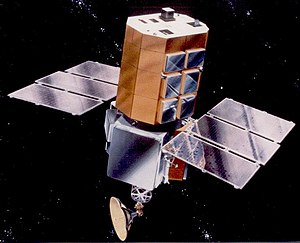Solar maximum mission
| Solar max | |
|---|---|

|
|
| Type: | Solar observation satellite |
| Country: |
|
| Operator: |
|
| COSPAR-ID : | 1980-014A |
| Mission dates | |
| Dimensions: | 2315 kg |
| Size: | 4 m length |
| Begin: | February 14, 1980, 15:57 UTC |
| Starting place: | Cape Canaveral , LC-17 |
| Launcher: | Delta 3910 |
| Flight duration: | 9 years |
| Status: | burned up on December 2, 1989 |
| Orbit data | |
| Rotation time : | 94.8 min |
| Orbit inclination : | 28.5 ° |
| Apogee height : | 512 km |
| Perigee height : | 508 km |
The NASA -Satellite Solar Maximum Mission ( SMM ), also SolarMax called the observation of the sun served, particularly solar flares . It was manufactured by the Fairchild company and launched on February 14, 1980 by a Delta rocket . The Solar Maximum mission ended on December 2, 1989 when the satellite entered the Earth's atmosphere and burned up.
Instruments
The satellite was equipped with the following instruments:
- Irradiance meter: ( Active Cavity Radiometer Irradiance Monitor , ACRIM)
- Spectrometer for gamma radiation (Gamma-Ray Spectrometer, GRS)
- Spectrometer for hard X-ray radiation (Hard X-Ray Spectrometer burst, HXRBS)
- Polychromator for soft X-rays (Soft X-Ray Polychromator, XRP)
- Hard X-ray Imaging Spectrometer, HXIS
- Spectrometers, polarimeter for ultraviolet radiation (Ultraviolet Spectrometer and Polarimeter, UVSP)
- Coronograph
Repair in space

In January 1981, three fuses in the satellite's attitude control unit blew. As a result, it was no longer possible to align SMM precisely with the sun. On April 6, 1984, the space shuttle Challenger SolarMax flew to during its STS-41-C mission . The satellite was hoisted into the space shuttle's payload bay in order to carry out maintenance and repair work ( on-orbit servicing ). This extended the life of the SMM satellite by a few years. The mission was portrayed in the 1985 IMAX film The Dream Is Alive .
Solar Max was the first satellite to be captured, repaired, and relaunched in space.
Results
Remarkably, the SMM's Active Cavity Radiometer Irradiance Monitor ( ACRIM) instrument set showed that contrary to expectations, the sun is brighter during the maximum of the sunspot cycle (the point in time with the most sunspots). This is because the sunspots are framed by so-called faculae , which more than compensate for the darkening effect of the sunspots.
Between 1987 and 1989 ten sun-grazing comets were discovered with the coronograph .
Individual evidence
- ↑ Sungrazing comets. United States Naval Research Laboratory, accessed February 26, 2010 : "The CP coronagraph on the Solar Maximum Mission (SMM) discovered 10 sungrazing comets between 1987 and 1989."
Web links
- SMM at the High Energy Astrophysics Science Archive Research Center (HEASARC; English)
- SMM at the Jet Propulsion Laboratory (English)
- SMM at the Marshall Space Flight Center (English)
- The Solar Maximum Mission (English)
- Repairing Solar Max (English)
